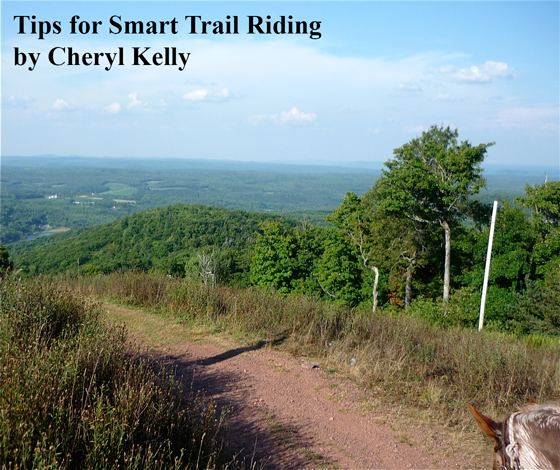Tips for Smart Trail Riding
by Cheryl Kelly

Trail riding has always been an adventure for me. I have traveled the road (or in this case the trail) less taken, and on more than one occasion, my horse had better judgment when it came to the unexpected. I appreciated his knowledge and guidance and he also had a pretty good sense of the direction home; as most do.
A pleasure ride can easily turn to fear and can be dangerous if certain precautions are not taken into consideration. Safety for you, and your horse is the foremost consideration. You never know what you may encounter on the trail and planning ahead can help you avoid an incident or an accident.
Before planes, trains and automobiles, the trails were the route for all means of travel. Paths were carved out of rural terrain to make way for all traveler’s designations; which then became byways for easier travel. Today horse trails are popular for pleasure riding. There are many riding clubs and organized groups that enjoy day rides, long distance cross country trips and camping adventurers. Competitive and endurance rides are also a judged discipline.
Unfortunately, many state and local parks have closed due to lack of municipal funds. There are many non-profit organizations lobbying for this urgent matter concerning the loss of open land which threatens the future of equine activity in the United States. Information for state parks and recreation area closures can easily be found online.
Here are a few tips for the trail:-
Choose a suitable equine partner. You need to know your horse has good manners. A trail horse must be a steadfast, adventurer, and capable of enduring everyday obstacles. Ideally he will be good at the following:-
• Going up and down hills.
• Crossing ditches, bridges, cross water and unstable terrain such as loose rocks, holes, logs and heavy underbrush.
• Coming upon unusual vehicles while crossing and riding alongside roadways and traffic.
• Encountering domestic animals and wildlife that are unfamiliar.
• Drastic climate changes: inclement weather which can change the scene.
• Snow, sleet, and hail.
• Fog, which can cause an unclear vision.
• Thunder and lightning, which can produce extremely dangerous conditions along with wind, dust and rain.
Also you should follow these tips for riding safely with others:-
• Always be considerate of others you are riding with.
• Don't tail gate, stay one horse distance between to avoid altercations such as biting and kicking.
• Horses feel safest among a herd; stay with the group that rides on your level. Some more experienced riders might want to venture ahead at a quicker pace.
• When passing another rider announce a 'heads up', and walk by, do not trot or cantor as this can excite, or spook even a calm horse.
• Maintain control at all gaits. Don't let your horse choose the pace; any change should be at the discretion of you, the rider.
• Redirect the attention of a horse that would like to 'hurry home',traversing or flexing might be effective.
Other ways to maintain as much safety as possible is to stay on designated marked trails as this can prevent injuries. Also bring along a cell phone and identification especially if you are riding alone. It is imperative you always let someone know where you will be riding and when you will return.
And don't forget to check your tack; check your protective head gear making sure it fits properly and is in good repair and bring along a first aid kit for horse and humans. Obey the rules of the trail and remember to respect the property of others.
Happy trails...


